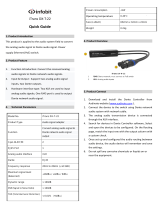
Issue 4, November 2021 Model 5205 User Guide
Page 6 Studio Technologies, Inc.
Model 5205
Mic/Line to Dante Interface
condenser, dynamic, or ribbon micro-
phones are compatible, as are most bal-
anced and unbalanced analog line-level
sources. The simple user controls, along
with an extensive set of status indicators,
help to ensure optimum performance is
maintained. With the unit’s compact size
and PoE powering, it’s simple to deploy
multiple units to integrate a distributed set
of sources into a Dante application. For
permanent applications there’s no reason
why a Model 5205 can’t reside within an
equipment rack or be mounted, using op-
tional brackets, underneath a table or on-
air studio set. In a conference room setting
the unit can be permanently connected to
a PoE-enabled Ethernet port, ready to ac-
cept a signal source from various user-pro-
vided devices.
Mic/Line Inputs
Two microphone or line-level analog
audio signals can be connected to the
Model 5205’s 3-pin female XLR connec-
tors. The preamplier gain of each chan-
nel can be independently adjusted from
among six settings: 0 (line), 20, 30, 40,
50, or 60 dB. To support condenser micro-
phones P48 phantom power can be inde-
pendently selected as required for each
channel. LEDs are provided to display the
conguration of the gain and P48 phantom
power functions.
Six pushbutton switches, located on the
Model 5205’s front panel, allow local
selection of the preamplier gain and P48
phantom power on/o status. The STcon-
troller application allows personal comput-
er users to both view and change the gain
of the preampliers and the on/o status of
the P48 phantom power sources.
Audio Quality
The Model 5205’s audio performance is
very good. The low-noise, wide dynamic-
range preamplier circuitry ensures that
input audio quality is preserved. The outputs
of the preampliers are routed to high-per-
formance analog-to-digital conversion (ADC)
sections that support sampling rate of 44.1,
48, 88.2, and 96 kHz with a bit depth of 24.
A precision voltage-reference integrated
circuit supports the ADC circuitry in perform-
ing accurate signal conversion. The audio
signals, now in the digital domain, are con-
nected to the Dante interface section where
they are packetized and prepared for trans-
port over Ethernet. The P48 phantom power
source is extremely low noise, providing
microphone power while causing little signal
degradation. This is important for demand-
ing applications.
The mic/line inputs were carefully designed
for use in permanent, as well as portable
and eld, applications. Extensive ltering
minimizes the chance that radio frequency
(RF) energy will interfere with the audio
input signals. Other components were in-
cluded to specically address ESD (“static”)
situations, helping to ensure long-term
reliable operation.
Metering
Two 8-step LED meters provide a real-time
level indication of the two Dante transmitter
(output) channels. Scaled in dBFS (decibels
referenced to full scale digital) the meters
oer a direct view of the audio signal levels
as they are transported via Dante in the
digital domain. This is important as optimal
audio performance requires transporting
signals at their proper levels — without an
accurate indication this can be dicult to
achieve.





















